By Natalie Navarrete
In the wake of the 2016 election, discussions about illegal immigration from Latin America in domestic politics took a dangerous and belligerent tone. Facts were thrown out of the window in exchange for xenophobic dog whistles and catchy sound bites that were easier to process and accept as the cause for any economic problem Americans might be facing. However, it is this very rhetoric that masks the true status of the immigration crisis, leaving all parties involved unable to address the conflicts at the center of this issue. Most detrimental to finding a solution to the immigration crisis is the way that the media and politicians talk about our biggest ally in this conflict: Mexico. President Trump, in an attempt to further progress on his campaign promise of restructuring America’s immigration system, has repeatedly threatened to raise tariffs on Mexico. President Trump has justified these tariffs by saying that they are a punishment for Mexico’s failure to prevent people from entering the United States illegally. These policy proposals and the anti-immigrant rhetoric coming from the White House dominate media coverage of this issue, ignoring both consequences of these actions and what Mexico is currently doing to halt illegal immigration.
Mexico is an important ally when it comes to addressing illegal immigration, especially with changing demographics showing that today the majority of illegal immigration comes from more distant Central American countries, not our immediate neighbor to the South. In fact, there have been more apprehensions of Central Americans than Mexicans at our border every year since 2016. In 2018, 62 percent of all apprehensions at the border were not from Mexico. The problem then is not immigration from Mexico, but rather containing the illegal immigration that comes through Mexico from other countries. There is a misconception that Mexico has not been doing its part in providing this security. The Comisión Mexicana de Ayuda a Refugiados (COMAR) and the Instituto Nacional de Migración (INM) are both agencies placed at Mexico’s southern border, tasked with addressing illegal immigration by providing services to refugees and asylum-seekers, and carrying out deportations and apprehensions, respectively. Unfortunately, these programs, particularly COMAR, suffer from inefficiency that pushes many immigrants to resort to illegal border crossings. This backlog is largely due to a lack of funding. U.S. investment into COMAR has stagnated at just $2 million per year, despite a 169 percent increase in illegal crossings at the U.S.-Mexico border in 2016. Mexico has been willing to work with the U.S. on the reduction of unauthorized border crossings, but the White House simply hasn’t been supporting efforts to do so as the Trump administration slashes aid across the board in Latin America through agencies like USAID.
At first, it seemed that President Trump’s threats would have little effect on Mexican President Andrés Manuel López Obrador, who hit back, declaring that “social problems are not resolved with taxes and tariffs,” chastising President Trump for turning his back on a country trying to work together with the US to solve a common problem. However, as time passed, President Trump’s determination made the possibility of tariffs seem more and more credible. Currently, Mexico’s exports to the US are $195 billion, which makes up 38 percent of Mexico’s GDP. The proposal of a 25 percent tariff would make trade with Mexico unprofitable to the U.S., meaning the flow of money between the two countries would virtually halt. Ironically, not only would this result in the collapse of the Mexican economy, but it would also lead to illegal immigration from Mexico increasing dramatically as entire industries shut down. This scenario put incredible pressure on President Lopéz Obrador to take action. With his efforts ignored and the threat of economic catastrophe on the horizon, President Lopéz Obrador had resorted to new measures, this time more in line with President Trump’s vision for immigration reform. “The sovereignty of Mexico is defended. At the same time, we do not want confrontation,” explained President Lopéz Obrador. “We have a frank, open hand extended to all the governments of the world, and we embrace all the people of the world, and we are especially interested in a good relationship with the United States.” As a result, 27,000 troops from Mexico’s National Guard have been moved to the U.S.-Mexico border, effectively militarizing the region. The efficacy of this tactic is yet to be tested or evaluated. More importantly, however, the lack of response to the needs of asylum-seekers and refugees, who will face another blow as funding continues to be siphoned into these more aggressive programs, is only going to be perpetuated. Gretchen Kuhner, director of the Institute for Women in Migration, is frustrated by this decision, which she believes will lead to even more dangerous conditions for immigrants in search of legal entry into Mexico or the US. “The message given is that Mexico is not interested in protecting people that are in need.” Through her research conducted on migration studies at Universidad Nacional Autónoma de México (UNAM), in Mexico City, Kuhner has seen how policy like that of the current administration and a lack of cooperation between Mexico and the U.S. negatively impacts families and women in particular. This creates increased dangers and traffic on the path to the U.S. that ultimately will only keep both parties farther from their objectives.
